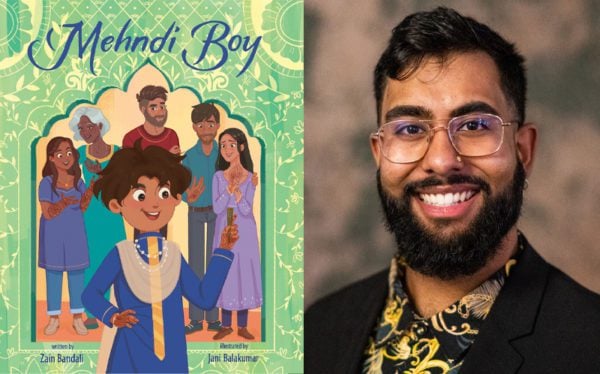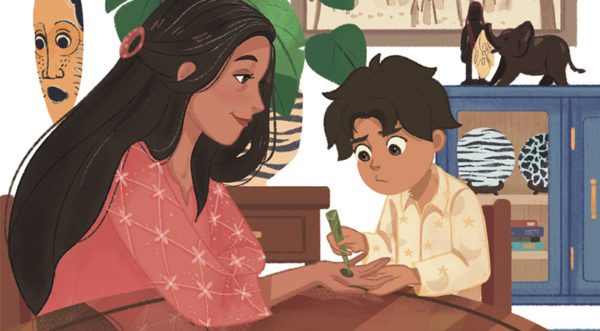
Zain Bandali (Credit: Arthur Mola)
A paean to the richness of culture and the inclusivity of art, Mehndi Boy by debut author Zain Bandali is a captivating early chapter book that is as intricate and lush as the henna that guides its protagonist, Tehzeeb, through a journey of self-affirmation.
Tehzeeb is a young boy who loves fashion and art. He dreams of donning royal blue kurtas, and pearls around his neck, of walking through decorations of fresh marigolds and roses, where everyone is resplendent in gold jewellery.
Like the author, Tehzeeb’s family moved from India to Tanzania a few generations ago, and then to Canada, meaning that celebrations like Navroz – the first day of spring – bring together an assortment of the finest Swahili, Gujarati, and Kutchi delicacies.
Tehzeeb inhabits a beautiful world, filled with loving family, Bollywood movies, sugary-sweet doughnuts, and his faithful stuffie, Mr. Unicorn. Tehzeeb and his family are heading to Ayaz Uncle’s house to celebrate Navroz, where it is announced that Tehzeeb’s cousin Rahima is engaged. To mark the special occasion, Rahima has with her Jenny Bai, the most famous mehndi artist in town. Jenny Bai offers to draw henna on Tehzeeb. As the green-brown icing-like paste is dotted and swirled across his palm, aromatic cloves, mint, and eucalyptus fill the air. Tehzeeb’s heart dances – here he is, an artist, witness to a new art form, where skin becomes the canvas. His artistic inclinations with henna soon have him dubbed the Mehndi Boy.

Illustration: Jani Balakumar
When he shows his favourite uncle his art, Ayaz Uncle’s face turns cold. He tells Tehzeeb that mehndi is for girls and ladies, not boys, and what Tehzeeb is doing is wrong. Through a whirlwind of events, Tehzeeb tries to suppress his passion, but as wedding events come to a head, he is called upon to do mehndi for Rahima. His work earns him the admiration of many, except Ayaz Uncle, who remains rigid, with his chin up and eyes cast down in judgment. But Ayaz Uncle, with the gentle nudging of his daughter, soon realizes that his own love of art is about progress and expression, not restriction. When Tehzeeb decides to face his uncle after the ceremony, Ayaz Uncle speaks first: I am sorry, he says, for telling you that boys shouldn’t wear or do mehndi. At that assurance, Tehzeeb’s eyes fill with tears.
This is a testament to the power of art to challenge the rigidities of bias and triumph over discrimination.
Illustrator Jani Balakumar brings life to the characters and their interactions with her Pixar-style whimsy and designs. The characters’ eyes are large and expressive, and their skin tones are rich with earthen hues. As vivid as Tehzeeb’s dreams, Balakumar imbues the story with colour that heralds the start of spring, the extravagance of a wedding, and the diversity of the characters and their burgeoning emotions. She is not shy to make an ample body, or add texture to the skin of older characters. The hair is thick and thin, dark and grey, richly woven, and braided. Surely, Balakumar displays an artistic panache worthy of Tehzeeb’s admiration.
Mehndi Boy reminds us why #ownvoices matters. Colonial narratives have long depicted certain religious and cultural traditions as antiquated practices at odds with progress. These narratives are not only false and harmful, but become weaponized to further agendas of hegemony. When addressing culturally sensitive issues, especially as they pertain to gender roles and expression, Bandali pays homage to the rich panoply of Indo-African culture, and shows that, like art, cultural traditions are vibrant and ever-moving.
 Contact us via email
Contact us via email

